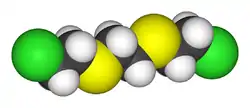Sesquimustard
Sesquimustard (military code Q, also known as One-and-one-half mustard) is a vesicant chemical weapon, a type of mustard gas. In its pure form it is more toxic and has up to five times the potency as a vesicant compared to standard mustard gas, though it is a solid at room temperature and so was only ever deployed as mixtures with the original mustard, with phosgene, or as a solution. Since 1997, it has been listed under Schedule I of the Chemical Weapons Convention, as a substance with few uses outside of chemical warfare[1][2][3] (although since then, it has been found to be useful in chemotherapy).[4]
 | |
| Names | |
|---|---|
| Preferred IUPAC name
1,2-Bis[(2-chloroethyl)sulfanyl]ethane | |
| Other names
Agent Q TL-86 | |
| Identifiers | |
CAS Number |
|
3D model (JSmol) |
|
| ChemSpider | |
PubChem CID |
|
| UNII | |
CompTox Dashboard (EPA) |
|
InChI
| |
SMILES
| |
| Properties | |
Chemical formula |
C6H12Cl2S2 |
| Molar mass | 219.18 g·mol−1 |
| Appearance | Pale brown crystals |
| Melting point | 56.5 °C (133.7 °F; 329.6 K) |
Solubility in water |
Insoluble, slowly degrades |
| Solubility | Alcohols, hydrocarbons, lipids, ethers, THF |
Except where otherwise noted, data are given for materials in their standard state (at 25 °C [77 °F], 100 kPa).
Infobox references | |
See also
- Half mustard
- HN3 (nitrogen mustard)
- O-Mustard
- Selenium mustard
References
- Vocci, Frank J.; Ballard, Thomas A.; Yevich, Paul; Punte, Charles L. (1963). "Inhalation toxicity studies with aerosols of sesqui-mustard". Toxicology and Applied Pharmacology. 5 (6): 677–684. doi:10.1016/0041-008X(63)90061-9. PMID 14082474. S2CID 2261517.
- Gupta, A.K.; Dubey, D.K.; Kaushik, M.P. (2007). "A simple and economical chemical neutralization method for the destruction of sulfur mustard and its analogues". Journal of Hazardous Materials. 139 (1): 154–159. doi:10.1016/j.jhazmat.2006.06.016. PMID 16846683. S2CID 36625534.
- Blum, Marc-Michael; Richter, Annika; Siegert, Markus; Thiermann, Horst; John, Harald (2020). "Adduct of the blistering warfare agent sesquimustard with human serum albumin and its mass spectrometric identification for biomedical verification of exposure". Analytical and Bioanalytical Chemistry. 412 (28): 7723–7737. doi:10.1007/s00216-020-02917-w. PMC 7550388. PMID 32902690. S2CID 221542205.
- Smith, Susan L. (27 February 2017). "War! What is it good for? Mustard gas medicine". CMAJ. 189 (8): E321–E322. doi:10.1503/cmaj.161032. PMC 5325736. PMID 28246228.
This article is issued from Wikipedia. The text is licensed under Creative Commons - Attribution - Sharealike. Additional terms may apply for the media files.